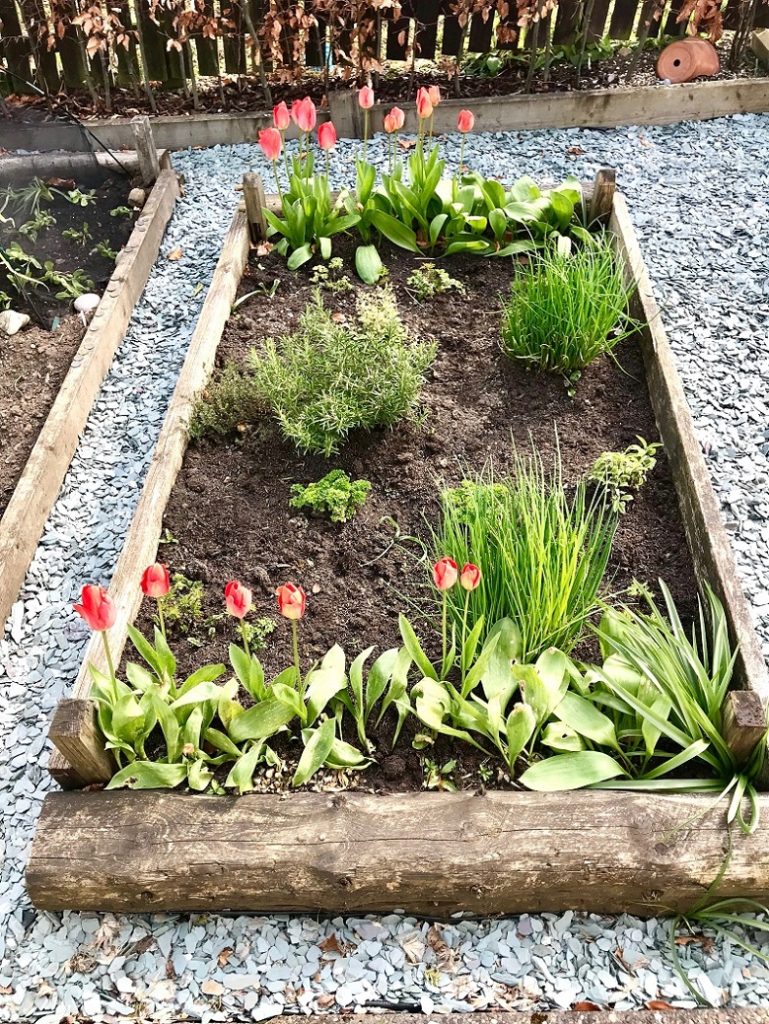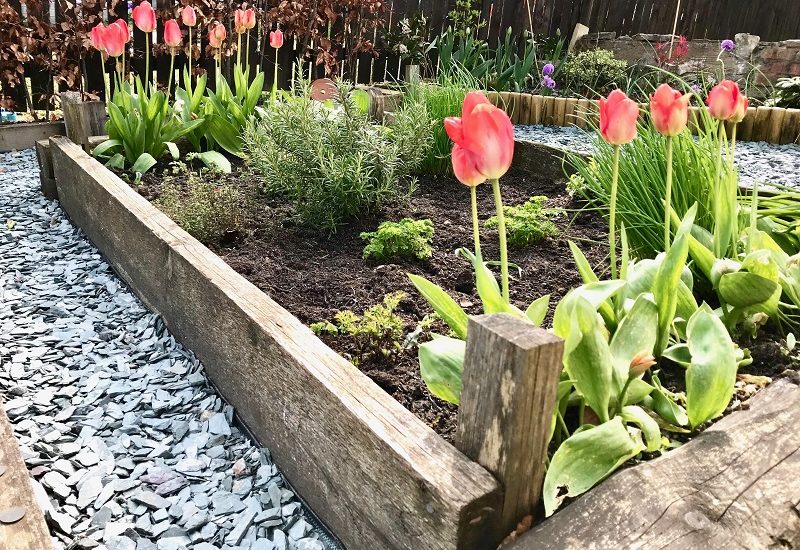In response to my previous post on how to grow sunflowers, a women on Instagram expressed a concern to me that she assumes there is more involved to gardening than just putting plants in the ground.
Now I do not claim to be a gardening expert, far from it. My garden has been an experiment in more ways than one over the last two years. But honestly, 9 times out of 10 that has actually been the case. And this sorta fly by the seat of your pants thing about gardening is why I love it so much in the first place. There’s no one there to tell you what to do, there are no real rules, you just play about with plants and mud until one day it looks great. And its so easy to pick up skills and knowledge through this trial and error approach that before long you do know what you’re doing.

Our Herb Garden
We were lucky to have inherited a fairly established garden with several raised beds, 1 of which contained chives and fennel, when we bought this house 2 years ago. I think it was having these herbs already established and looking pretty healthy (despite me having zero experience at that point in gardening) which gave the confidence to expand it.
Over the last two years I’ve slowly added to this little herb garden with rosemary, sage, curly parsley, thyme, and oregano. All to very good success. I did ditch the fennel cause I don’t like the stuff but even that was easy to grow, even with a great deal of neglect and cutting it back.

I also grow pot of bay on my front doorstep, I have mint in a pot at the top of the garden, and every year I pot up basil to enjoy throughout the summer months.

If you’ve ever thought about growing your own herbs I highly recommend it. There is something indescribably gratifying about making pesto from your own basil, or being able to grab a few bay leaves from your front step to chuck into a bolognese. And for me, our small herb garden has been an easy entry route into growing more of my own food.

So far and over the last two years I’ve grown courgette, garlic, spring onions, radishes, rocket, rhubarb, and shallots. All with success, and all easy and manageable with my little knowledge, skills, and equipment. But most importantly growing just herbs has saved me money in the long run, I’m reducing my plastic consumption and my food waste because I’m no longer buying those expensive plastic packets of herbs from the supermarket, and I only pick what I need for that meal.
Starting your own herb garden
It’s easy and relatively cheap to get started on your own herb garden. You don’t need a greenhouse, and you don’t even need to sow any seeds. Most garden centres will now be selling small pots of herbs which are ready to eat and you can expect to pay around £10 for 3 pots.
If you have a garden then any small patch of soil will do although do make sure it gets most of the sun throughout the day. If you have a shady garden, then consider growing herbs in container so you can place them in sunny spots in the garden. Same goes if you have a balcony or live in a flat: place your containers in a sunny area or windowsill to give them the best chance.

In my experience, living in a very exposed garden in Scotland, herbs like chives, rosemary, sage, thyme, parsley, and bay will do fine outside all year round, and they’ll keep growing back year after year. Basil on the other hand, is an annual (so it lasts one year) and is tender so really ought to be in a greenhouse or sunny windowsill in this part of the country, unless of course we have a good summer. So I prefer to have it in a pot which I keep in the sunny spot of the garden or move it out of the prevailing wind when it strikes.
Herbs to grow and where to buy them
I’ve listed a bunch of herbs you can easily grow. Yes its cheaper to grow herbs from seed, however if you don’t have the time, inclination, confidence, or equipment to do so then buying small plants, cuttings, or plugs (i.e. seedlings) are just as well and really not that expensive.
I’ve always bought all my herbs from garden centres but most supermarkets sell pots of herbs and you can order online. Do also check out plant nurseries, car boot sales for cheap plants and most gardeners are happy to give away cuttings from their own garden.

- Parsley
- Bay
- Sage
- Coriander
- Thyme / Lemon Thyme
- Dill / Fennel
- Chives
- Rosemary
- Lavender
- Basil
- Mint
- Marjoram
- Tarragon

What you need
- Any container, a raised bed, or a patch of soil
- Gravel (for containers)
- Small selection of potted herbs or plugs
- Trowel (or large spoon if you don’t yet have garden tools)
- Fertiliser (i.e. fish, blood, and bonemeal)
- Plant feed (tomato feed is good)
- Peat-free compost (if using a container)
- Scissors or pruning shears
If you’re planting straight into the soil or in a raised bed then it’s a good idea to feed the soil with fertiliser first to ensure you have optimum growing conditions. I like to generously fork fish, blood, and bonemeal (which comes in a box as a grainy powder) into the soil first. This fertiliser is good for establishing healthy root growth in all plants (so you can re-use it again) and contains all the nutrients plants need.
Place the pots of herbs onto the bed to help you decide which layout you like best. It doesnt really make a difference how you lay our your herbs, but it might be a good idea to place the larger ones at the back or you might want to create some symmetry, or you may wish to have the herbs you will use more regularly at the front and easier to access.
Once you know where you want your plants to go, dig a hole the size of each pot, carefully tap the plant out of the pot (being careful not to break the roots) and place into the hole. Back fill the hole with soil, and press down firmly around the base of the plant to remove any air pockets. Give it a generous drink of water, and repeat with the rest of your herbs.
If instead you’re planting into containers, then make sure there is sufficient drainage holes at the bottom of the containers. Most pots come with drainage holes but you may need to drill new holes if you’re using a non-traditional container.
Fill the bottom of the container with gravel (I use the gravel in my driveway) and this will stop the soil compacting into the holes which will prevent water from draining out. Half fill the container with peat-free compost and add a sprinkling of fertiliser. Tap the herbs out of their pots, place into the container and back fill the hole with more compost. Pressing down lightly to remove air pockets. Give a good drink of water until you see water draining out of the bottom.
Rather than several containers, you can plant all of your herbs (with the exception of mint) into one container but do make sure it is large enough to allow for future growth.
You could start picking your herbs straight away but I’ve personally always preferred to give them a couple weeks to get their roots established and growing well in the conditions before I start harvesting any leaves.

Tips
- If you can, it’s a good idea to have your herb garden as close to your back door or kitchen as possible, for ease of access when cooking.
- Any plants in containers will need to be watered more often than those in the ground. Have a feel of the soil just under the surface and water when it feels dry.
- Feed the plants with a liquid fertiliser (tomato feed is good)
during spring and summer, every 2 months to keep them healthy. - Be cautious about planting mint in the ground. This will spread thick and fast, and can easily take over an entire area like a weed. It’s best growing mint in a separate container on its own.
- Consider planting some pollinators into your herb garden, or in pots alongside, to encourage bees and butterflies. Also let some chives flower, their bright purple flower balls are really pretty and bees love them.
- Thyme and rosemary can be trimmed back every spring (just cut them with a pair of sharp scissors or pruning shears) to stop it growing woody. While herbs such as fennel, basil, and coriander ought to be picked or trimmed regularly to stop it bolting (this is when the plant flowers, creates seeds, and stop creating leaves).
- If you’re herbs have bolted then you can cut them down to ground level, leaving about an inch growth. Lay a thick layer of fresh peat-free compost around the base (this is called mulching), give it some more tomato feed, and usually within a couple weeks new growth will appear.
- If planting into the ground, mulch your herb garden in autumn. This will protect the roots and reduce weed growth during the cold winter months. You can mulch simply by piling peat-free compost, garden compost, or even grass clippings, thickly around the base of the plants.

